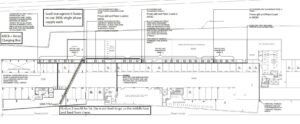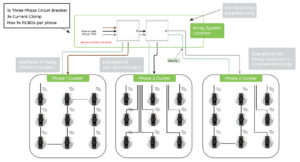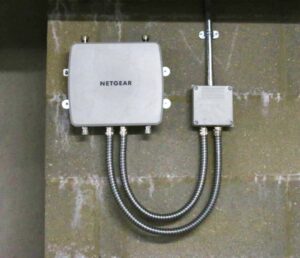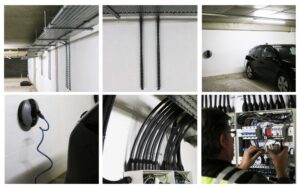Residential Development in Bow: Case Study
Pod Point installed a Load Balancing Solution for an underground carpark in a residential development in Bow.
Last updated: Apr 10, 2024 • 6 min read

Overview
- Devon’s Road, a new mixed-use development in Bow, East London, which features apartment blocks and individual residential plots along with a large underground carpark, lacked sufficient substation capacity for the electric vehicle charging infrastructure required to meet London planning conditions.
- Other challenges included the car park’s underground location and the potential lack of a 3G or 4G signal. Wi-Fi connectivity was required for the client to bill users of the chargepoints for their electricity consumption and to make load management possible.
- The client’s lack of experience in chargepoint systems meant they requested expert consultancy to create a bespoke solution that could charge multiple EVs reliably, conveniently and cost effectively, along with a phased implementation plan.
- Pod Point designed a load balancing system using its Array Charging box, a solution offering convenience, cost effectiveness and no administrative burden, enabling the client to meet both active and passive provision requirements.
Key Facts:
- 23 “active” and 23 “passive” chargepoints required
- Pod Point Array charging boxes powered with 100A three phase supply
- Each phase services up to 9 chargepoints
- 27 chargepoints can be installed from a 100A three phase supply
- 23 chargepoints wall mounted 7kW Solo chargers installed, each delivering 30 miles of range per hour of charge
- User pays via the Pod Point App, with billing process handled by Pod Point
The Development: Merchant’s Walk – Devon’s Road
Devon’s Road is a mixed use development comprising apartment blocks and individual plots, with a large underground car park in Bow, East London. In such developments a London-wide planning condition requires the installation of electric vehicle chargepoints in 20% of the development’s parking bays at build stage (“active” provision) and the provision of infrastructure for future installation of chargepoints in an additional 20% of the development’s parking bays (“passive” provision). In order to satisfy the condition there must be enough available power for both the active and passive provision. For Devon’s Road, the requirement equated to 23 active chargepoints, with passive provision for a further 23 chargepoints.
The Challenge
The Devon’s Road site did not have sufficient substation capacity to account for all 46 7kW chargepoints and upgrading to allow for a further 150kVA was not feasible, logistically or financially. Furthermore, the available supply to the underground car park was insufficient for the planned 23 chargepoints in that location. Under the British standard (BS7671) developers cannot allow for less than maximum demand, unless load control is in place:
“Where the final circuit supplies more than one charging point no diversity shall be allowed.
Diversity may be allowed for a dedicated distribution circuit supplying multiple electric vehicle charging points if load control is available.”
Other challenges included the car park’s underground location and the potential lack of a 3G or 4G signal. Wifi connectivity was required for the client to bill users of the chargepoints for their electricity consumption and to make load management possible.
The client had not encountered or installed an chargepoint system before and thus had limited understanding of how to successfully fulfil the requirements of the planning condition, or how to provide a system that would be fit for the purpose of charging multiple electric vehicles reliably, conveniently and cost effectively.

The Solution - Chargepoint Load Management
Pod Point Design Service
As well as providing chargepoints, systems and installation services for the Devon’s Road project, Pod Point also acted as consultant to the client; designing a bespoke solution and a phased implementation plan.
7kW Charging System – Active Provision
The client initially investigated providing 3 100A three phase supplies to cover maximum demand on 23 chargepoints in the underground car park. But it became clear that this would constrain available power to the rest of the site and even overload the substation during peak usage, this did not take in to account the passive provision required. Pod Point proposed an alternative approach.
By utilising a load management system only 1 x 100A three phase supply would be required for the active chargepoint. Each phase in the Array Charging box would have capacity for 9 chargepoints. This Array Charging box manages the 23 chargepoints to a minimum of 10A per chargepoint. A total of 27 chargepoints can be added to this system with a maximum load of 90A TP&N + 10% contingency.
This system reduced the load on the development and allow the client to fulfil their chargepoint quota from the planning requirements.
To implement the load management system for the active provision, each chargepoint required a shielded twisted pair cable to be daisy chained from the Array Charging box, as per the diagram below. This can be rated at 400V if required to allow this cable to be ran with the mains.

7kW Charging System – Passive Provision
The requirement for passive provision for the development was fulfilled by allowing for the required capacity for an chargepoint in each of the individual residential plots. In addition, a freestanding Pod Point Twin Charger was installed in between 2 car club spaces. While the Twin actually counted as active provision (meaning the client exceeded their requirement), it left just 21 chargepoints to be allowed for in future installations in the individual plots. Load management on the underground car park meant that sufficient substation capacity was available for this provision.
Connectivity/Billing
Billing is managed via a Wi-Fi connection. All Pod Point charging infrastructure is smart enabled and Wi-Fi connected. A Wi-Fi connection must be provided on site, allowing a tariff for usage of the charging points to be set at the client’s discretion. Pod Point manages the collection of funds through the Pod Point App.
As part of the design service, Pod Point advised that a suitable Wi-Fi system be installed in the carpark in positions that ensured strong connectivity is available to all 23 chargers.

The Result
23 wall mounted 7kW Solo chargers were expertly installed in the underground car park, utilising cable trays fit specifically for EV charging to run power and data cabling neatly at high-level, over a 50m stretch, and then down to each individual charger's position. The cabling from the tray to each charger ran behind the wall, giving a visually appealing “Floating Pod” appearance at each chargepoint enabled parking bay.

Thanks to the Pod Point Load Balancing System, all 23 chargepoints in the underground car park have the infrastructure to be used simultaneously from just a 100A three phase supply, saving the client significant budget and protecting the site’s electrical infrastructure. The 7kW chargers have the capacity to deliver up to 30 miles of range per hour of charge, which the resident will pay for via their Pod Point smart phone app. The client manages this by allowing only residents of the development access to the chargepoints, and setting a tariff to cover the cost of electricity used. Pod Point handles the full billing process, rebating the client and leaving them without an ongoing administrative burden.
Client endorsement:
“Pod Point really helped to drive this project forward. They looked at our challenges and created a bespoke solution that works for all stakeholders and does not utilise excessive amounts of power, allowing us to meet our planning requirements. Furthermore, Pod Point’s back office system works brilliantly for this type of development.”

